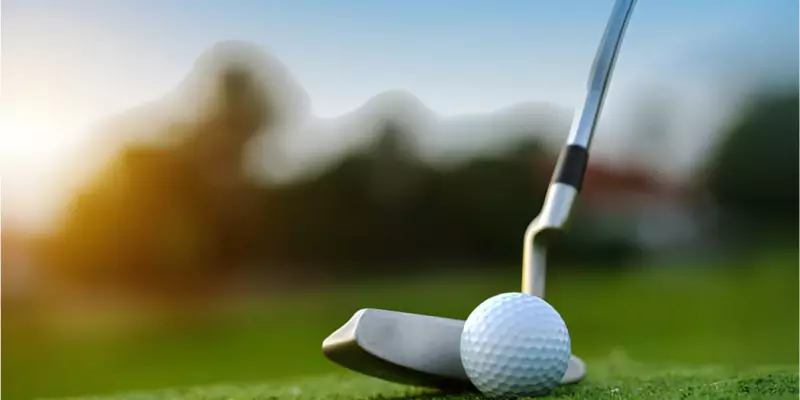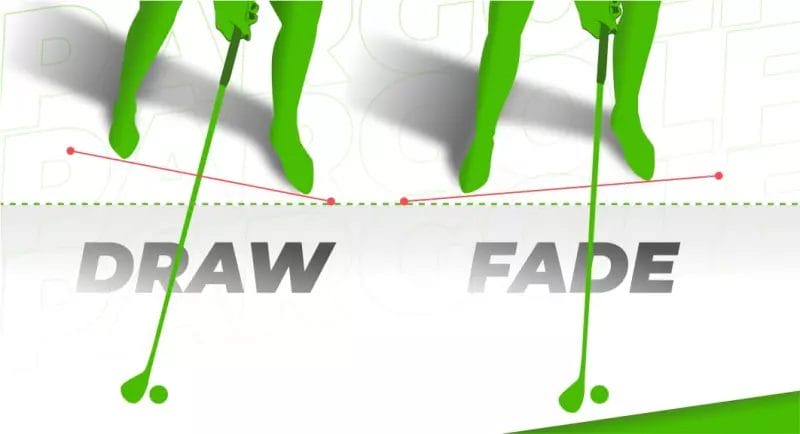When it comes to golf, players can hit a couple of different shot shapes effectively. Two of the most common shot shapes are the draw and the fade.
Understanding the differences between these shots and when to use them can significantly benefit golfers of all skill levels. This blog will explore the draw and fade, ranging from their differences to how to hit them.

Understanding a Draw vs Fade in Golf
The draw and the fade stand at the forefront in shot shaping. Understanding the concept of shot shaping in golf is essential because it directly affects the ball’s flight and landing angle.
Defining a Draw in Golf
A draw is a shot shape that starts slightly right of the target line (for a right-handed golfer) before gently curving back to the target line or even slightly left of it. A right-to-left ball flight characterizes the draw shot and is often preferred by golfers who prefer a lower lofted, less spinning golf shot.
To achieve a draw shot, golfers need to focus on their swing path, the position of the clubface at impact, and the alignment of their body relative to the target line. The club path of a draw is from the inside to the target line, creating an in-to-out path. This path, combined with a slightly closed clubface relative to the club path and target line at impact, imparts the spin necessary for the golf ball to draw.
Defining a Fade in Golf
In contrast to the draw shot, a fade starts left of the target line (for a right-handed golfer) before gently curving back to the target line or slightly right of it. A left-to-right ball flight characterizes the fade shot and is often preferred by golfers who want to produce controlled shots.
To execute a fade, golfers need to focus on their swing path, clubface position, and alignment. The swing path of a fade shot is slightly from the outside to the target line, creating an out-to-in path. This path, combined with a slightly open clubface at impact, imparts the spin necessary for the golf ball to fade.
In addition to understanding the swing path and clubface angle, generating backspin is crucial in shaping the fade shot for consistency and accuracy.

Benefits and Challenges of Draw and Fade
The draw and the fade shots offer unique advantages and challenges to golfers. Understanding these can help golfers decide when to use each shot shape and how to optimize their shots for different situations on the golf course.
Advantages of Hitting a Draw Shot
Hitting a draw shot offers several advantages, especially when navigating the golf course. Some of the benefits of hitting a draw shot include:
- Flexibility in shot shape, allowing golfers to shape shots around obstacles on the course.
- Lower, more penetrating ball flight. Ideal for windy conditions.
Disadvantages of Hitting a Draw Shot
While hitting a draw shot can be advantageous, there are also some challenges golfers face when trying to execute this shot shape:
- Hitting draw shots requires a strong grip, which can be difficult for golfers who prefer a more neutral grip.
- Consistently hitting draw shots requires precise clubface and swing path alignment, which can be challenging for golfers to maintain.
Advantages of Hitting a Fade Shot
Hitting a fade shot also offers several advantages that golfers can leverage on the course. Some of the benefits of hitting a fade shot include:
- The fade shot provides a controlled shot shape, which allows golfers to navigate the course more strategically.
- Fades offer the golfer the ability to tackle left-side pin placements with confidence.
- Mastering the fade shot adds shot shape versatility to a golfer’s skillset, enabling them to handle different course conditions effectively.
- A fade swing is more natural for most golfers.
Disadvantages of Hitting a Fade Shot
Though fade shots have their advantages, they also present some challenges for golfers. Some of the drawbacks of hitting a fade shot include:
- Hitting a fade could inadvertently result in a power fade or draw shot, taking the ball too far right off the target line.
- Courses that demand a draw shot shape can present challenges when hitting fade shots.
- In windy conditions, fade shots can get caught in the wind due to its high trajectory.
- Consistently executing fade shots requires maintaining the clubface angle and swing path, which can be difficult for golfers to achieve.

How to Hit a Draw
Mastering a draw can take time and practice, but with the right swing mechanics, golfers can successfully shape the golf ball from right to left. Here are some key tips for hitting a draw shot effectively:
Swing Mechanics for a Draw
To hit a draw shot consistently, golfers should focus on the following swing mechanics:
- Maintain an in-to-out swing path, with the clubhead slightly behind the hands at impact.
- Aim for a slightly closed clubface position at impact, in between the clubpath and target line.
- Position the ball slightly back in the stance to encourage the desired ball flight.
- Develop a smooth and controlled golf swing, paying attention to the clubface position throughout the swing.
- Practice swing path variations, clubface position adjustments, and alignment to fine-tune the draw shot.
Tips for Practicing Draw Shots
Golfers can incorporate specific techniques and drills into their practice routines to improve draw shots. Here are some tips for practicing draw shots effectively:
- Focus on consistent clubhead speed and swing plane when practicing draw shots.
- Experiment with ball positions to understand the impact on the ball flight.
- Fine-tune draw shots by making downswing alignment and ball position adjustments.
- Practice swing path variations to develop a reliable draw shot.
- Achieve consistency in draw shots by maintaining proper tee setup and alignment.
How to Hit a Fade
Executing a controlled fade requires specific swing mechanics and attention to detail. Here are some key tips for hitting a fade effectively:
Swing Mechanics for a Fade
To consistently hit a fade, golfers should focus on the following swing mechanics:
- Develop an out-to-in swing path, with the clubhead slightly open relative to the target line at impact.
- Aim for a slightly open clubface position at impact relative to the target line.
- Position the ball slightly forward in the stance to encourage the desired ball flight.
- Pay attention to the angle of attack, ensuring a slightly steeper path through the ball.
- Practice swing path variations, clubface position adjustments, and alignment to fine-tune the fade shot.
Tips for Practicing Fades
Golfers can incorporate specific techniques and drills into their practice routines to improve fades. Here are some tips for practicing fade shots effectively:
- Master the open clubface position relative to the club path and target line to produce fades consistently.
- Focus on the angle of attack to achieve a controlled fade ball flight.
- Experiment with swing path variations to create the desired fade shape.
- Practice ball position adjustments to control the amount of fade.
- Develop a strong grip to maintain better control over the clubface in fade shots.
Which Shot is Favored by Professional Golfers: Draw or Fade?
When it comes to professional golfers, the preference between the draw and fade shot shape can vary based on the golfer’s natural shot shape and the course layout. Many professional golfers have historically preferred one shot shape over the other, depending on their individual playing style and strategic approach to the game.
For example, legendary golfer Ben Hogan was known for his iconic draw shot. Hogan’s natural shot shape was a left-to-right fade, which he controlled masterfully. On the other hand, golfers like Lee Trevino, Rory McIlroy, and Jack Nicklaus have showcased the ability to shape the ball in both directions, using the shot shape that best suits the course and conditions.
Ultimately, the decision between the draw and the fade comes down to the golfer’s shot shape preference, natural tendencies, and the specific shot required in a given situation. Understanding the strategic advantage of a draw or fade is vital for professional golfers looking to optimize their performance on the course.
Master Shot-Shaping Today
While both shots have their advantages and disadvantages, it ultimately comes down to personal preference and playing style. A draw can add distance with a lower ball flight but requires precise swing mechanics and practice. On the other hand, a fade shot can provide accuracy and consistency, but it may sacrifice some distance.
Professional golfers often favor one shot over the other based on their strengths and the demands of the course. So, whether you choose to incorporate a draw or a fade into your game, remember to focus on proper technique and practice to master these shots. Keep honing your skills; soon, you’ll see a noticeable improvement in your golf game.
